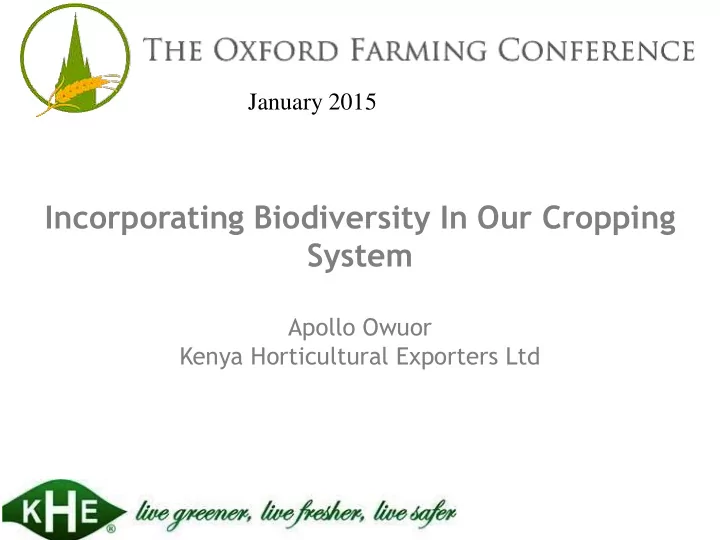

January 2015 Incorporating Biodiversity In Our Cropping System Apollo Owuor Kenya Horticultural Exporters Ltd
I NTRODUCTION • Head of Agriculture and CSR with KHE since 2003 Married with Two Daughters • Passionate about Agronomy and Social Responsibility • Overall aim to demonstrate substance & depth on all elements of land, resource and Sustainable Production system
Geography in Kenya Growing in Kenya • Equatorial position gives equal daylight Area - comparative: twice the size of Nevada and all year production. Climate: Tropical along the cost line to arid on Production is based around the Central the interior • Highlands which gives cool growing and Terrain: Low plains rise to central highlands access to International airport. bisected by Great Rift Valley; fertile plateau in west • Relatively abundant water – 2 rainy Natural Resources: Limestone, soda ash, salt, periods – November and March/April. gemstones, fluorspar, zinc, diatomite, gypsum, Fertile soils – 2 main types – black cotton • wildlife, hydropower (clay) and red volcanic mineral soil. Land Use: Arable land: 8.01% , Permanent Hottest period Jan-Feb, coolest July – • crops: 0.97%(2005) August. Irrigated land: 1,030 sq km (2003) • Diverse Climatic Range Total renewable water resources: 30.2 cu km Highest altitudes gives better light, lower • (1990) pest and fungal pressures. Natural hazards: Recurring drought; flooding during rainy seasons
About KHE Pioneering exporter from Kenya, in the late 60 ’s, instrumental in • identifying potential and developing the industry. . • Total weekly exports of 150 - 180 tons to UK. • Farming Operations 800 Acres in Nanyuki, Naivasha 800 Acres, and Embu 1000 Acres. We have total integration in Kenya to ensure leadership in all aspects of • good agricultural practice and care of the environment. • The Company has three BRC approved packing sites based in Nairobi, Mwea and Nanyuki. Approximately 1800 staff. 1200 on the farm and 600 in packing facilities, • the business supports these staff and makes an active contribution to the broader communities.
KHE has a proud heritage in commitment to sustainable practice and providing supporting for local communities. KHE endeavor to ensure positive impact on workers and communities and is at the heart of the companies philosophy. Responsible Employers • All sites exceed ETI base code standards. On site basic medical treatment • Transport to and from work (farms). • 85% subsidised canteen meals • Housing for key workers/all full time employees receive housing allowance • Counselling/support on HIV and Family planning. • The business engages with communities in broader support. • Community Health Centres (<2500> people receiving basic medical provision). • Schools (<2000> school places ) • Creches & Clinics A fairer way of trading……… encouraging growth Production to IFM standards. Responsible • Soil Management. • Sustainable rotation. Farming • Composting scheme yielding significant results. • Reduction in pesticide. • Biological controls, varietal development, complimentary planting. Protection of buffer zones and environmental areas and bio diversity preservation. Water sustainability management – irrigation systems, collection, mulches, compost. Energy management - low energy lighting, optimised journeys, minimised water pumping. Recycling of materials and water. Carbon Footprinting
G ROWING REGIONS Growing locations Nanyuki, Timau, Mwea, Embu. are all within 180km of Nairobi but have distinct climatic differences. Altitudes range from 1000m to 2500m and areas selected for varying attributes such as soil type, temperature and water availability and wind exposure.
Farming Operations and Infrastructure Ontilili Farm – Nanyuki • Based in Nanyuki – South, East Mt Kenya • Model Farm & Packhouse - 400ha site 150ha of production broken into 30ha blocks – Runner • Beans,, TSB, Peas, Fine Beans • Established & Industry leading CSR model in local community • Benefits secure land, water security – Recent addition of a large scale dam giving additional further 1 million cubes ! • IFM including wild flower borders • In house compost manufacture
Small Growers Small holder schemes • Gives 2000 small scale farmers to access the market. • Organised into CooPs and Small Holder Groups • Operate under Global GAP accreditation. • Acreage range typically from 0.5 to 2 acres per farmer • Provides a vital sustainable income (approx 4 x national average). • Schemes supported through community initiatives. • On the ground KHE management teams implement systems /controls. • Central group spray teams to control inputs. Developing the model – wider stakeholder engagement – bringing financial institutions and corporates into the mix • To provide the financial architecture to drive long term sustainability • Development of social and environmental component • Mobile phone technology to drive production capability • Crop insurance and Finance Private & Confidential
Our Crops
Bio-Diversity Approach Strategy: Agrochemistry to Agroecology (IFM) • Decreasing use of Chemicals in Crop production • Optimising Biological interactions • Increased biodiversity in Farming System (Stimulating • Biological Activities) • Understanding interactions of various life forms in the Farming ecosystem Resource use efficiency (Water, Carbon and Nitrogen) • Biological Nitrogen fixation • Green Manuring (Recycling) •
Adapted from Eric Scopel & Eric Maleziex CIRAD
Encouraging Pollinators Bees are usefull pollinators
Conserving Woodlands
Soil Care and Management
Mix Cropping
Integrated Fertility Management Trichoderma Stimulating Biological Activity Biological N fixation
Conservation
Pheromone Traps Pheromone Traps for Management of helicoverpa spp Reducing Dependancy on Chemical Applications
Resource Use efficiency • Soil Carbon • Nitrogen • Water
Corporate Social responsibility • Karii Dispensary: Fully Operational and now running 24 Hrs with Staff levels now at 20 from 2 Nurses 2 Years Ago • Muramati Dispensary: Maternity and LaB units under construction. Ground Breaking • Mashamba Boys Dorm: Thiba
Thank You
Recommend
More recommend